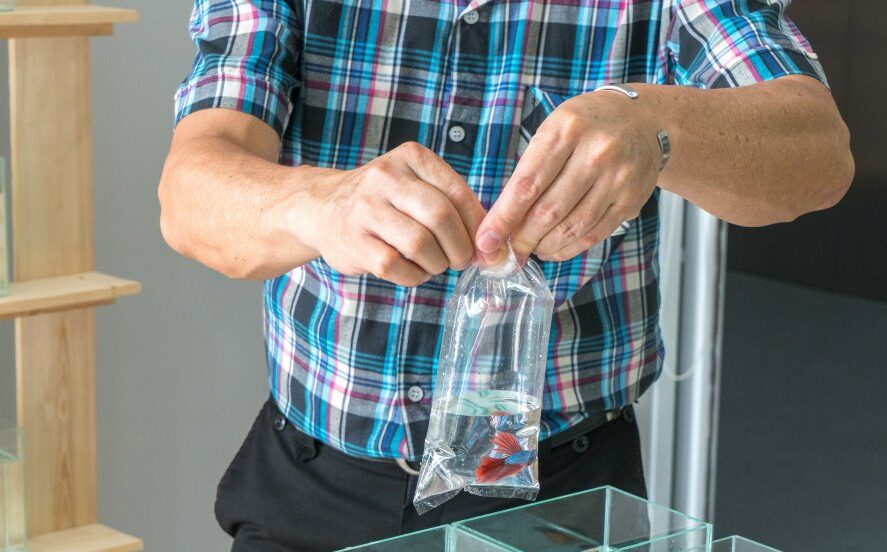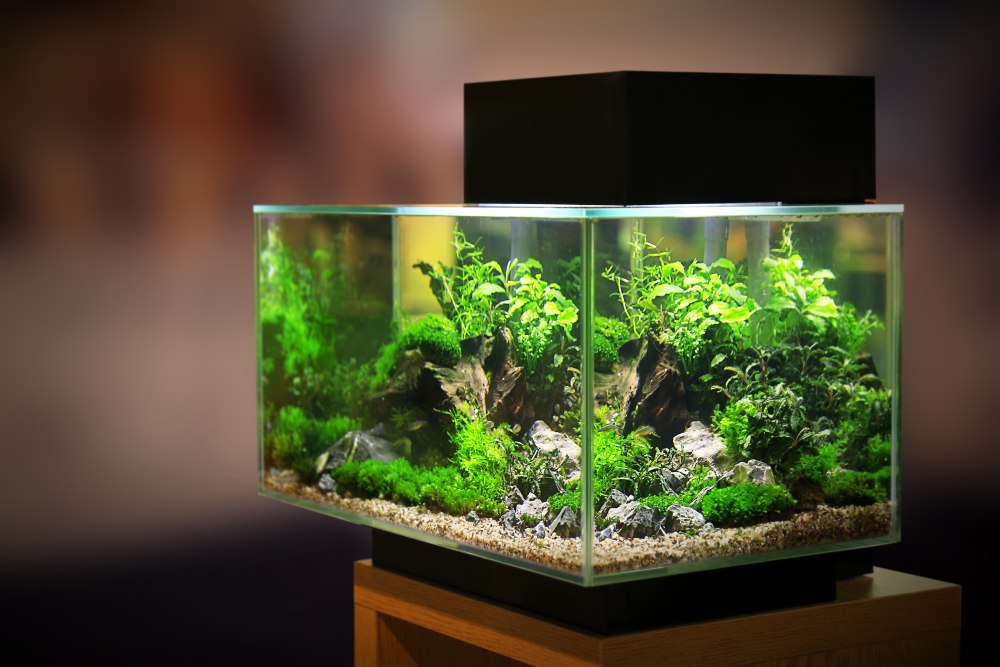Betta fish are easy to take care of once you know what they need and there are a few things you must be careful of so you don’t harm your betta fish unintentionally.
After you get your betta fish from the pet store (or rescue one), your first task would be to transfer it into its own tank.
New hobbyists often wonder when and how to transfer the betta fish in the new tank. Let’s learn.
What you need to consider before acclimating your betta fish

Betta fish are susceptible to water changes, therefore, when you transfer them to any new tank, you must be aware of the essential conditions needed for their healthy development.
It’s also important to note that when the pet store gives you the fish in a small cup, you should be careful that the ride home isn’t very bumpy, which may stress out the betta.
Now let’s talk about creating a suitable environment for your tropical fish.
First of all, ensure water parameters are at their ideal levels along with the water temperature. Betta fish are quite sensitive to water conditions. As they’re tropical fish, bettas are used to living in warmer waters, so try to provide roughly the same temperature in the aquarium water.
The new tank water temperature should be around 75 to 80 degrees F, similar to the betta’s original habitat. Now comes the most important question, when to transfer the betta fish to its new environment. The answer will vary based on whether you are keeping the betta fish in a completely new tank, community tank, or in a cycled tank, which we’ll discuss in the following section.
But you can’t keep the betta fish too long in the cup of water as most of them don’t get proper ventilation, which prevents proper oxygen flow. So, the earlier you can transfer the fish into its new betta tank, the better.
How to acclimate your betta fish: a detailed guide

As also mentioned above, acclimating your fish to the new fish tank will vary based on where you are keeping it. Let’s see the betta acclimation process for each type.
Betta acclimation in a completely new tank
If you are transferring your betta to a whole new betta fish tank, here are the steps you must follow.
Choosing a fish tank for your betta
These native Asian fish are used to living in stagnant water, but bettas can adjust well in the aquarium environment too. However, try to get a bigger tank so that the betta gets enough space. An aquarium that can hold at least five gallons of water will be a suitable tank for your pet fish. Don’t get a tank smaller than five gallons capacity, which will stress out the fish.
You also don’t need any filtration system in the aquarium because bettas take air directly from the surface of fish tank water.
Preparing the tank
After you get the new aquarium, it’s time to prepare it for the betta fish. Wash the tank thoroughly in hot tap water and also rinse the gravel carefully. Avoid using soap or detergent for cleaning the tank as the residues are harmful to fish’s health.
Also, wash the aquarium decorations well and place them back into the tank. Now it’s time to add the gravel carefully. Pick up relatively small-grained gravel, which makes cleaning the betta tank much easier.
Filling up the aquarium
Once you are done cleaning the aquarium, it’s time to fill it. Avoid using mineral water for the tank; instead, use tap water. Mineral water lacks many essential minerals needed to keep the betta healthy.
Also, don’t fill the fish tank to the brim because bettas don’t breathe underwater; instead, they get air from the surface. This is also why keeping betta fish in a small container is not safe, as the fish doesn’t get enough breathing space.
Use a water conditioner
Tap water may contain substances like chlorine, which is toxic for betta’s health. Therefore, a water conditioner bottle will come in handy to get rid of such things. Also, tap water may contain heavy metals, due to which using a water conditioner is vital.
You will get a water conditioner specifically made for betta fish in any fish or pet store. Read the instructions on the package to know the quantity and procedure of using the conditioner in the new tank.
Betta acclimation in a community tank
We would suggest you keep your betta fish in an isolated tank only as they don’t adjust very well with other fish. But if you are planning to keep the betta in a community tank, there are a few things you should follow.
After getting the baby betta, keep it in a quarantine tank for two to four weeks. The period will allow you to see if your fish has any disease and treat it accordingly. Introducing to its new tank mates directly is not the right choice as the betta can be a bearer of diseases for the other fish.
Once the betta completes the quarantine period, you may transfer it to its new habitat. Additionally, the water and aquarium conditions should be the same as keeping it to a new tank.
Betta acclimation in A cycled tank
As fish waste contains ammonia, you need a way to turn that ammonia into beneficial nitrate. The solution? A cycled tank. A cycled tank is a filtration system where there’s a colony of bacteria that removes harmful waste within your tank.
The bacteria turns the ammonia into nitrite, and then turns the nitrite into nitrate!
If you already have a cycled tank, there is nothing much you need to do. The water parameters like pH level and temperature are already at their ideal levels, so you can proceed with transferring the fish to its new tank.
Time to introduce the betta fish to its new habitat

Once your tank is ready, it’s time to transfer your betta fish from cup to tank.
Here is how:
- First, check the pH levels and water temperature of the betta cup or plastic bag, and then check the same of your aquarium water.
- If both the levels match, you can directly place the betta fish in the tank water.
- In case the measurements don’t match, you should let the plastic cup or bag float in the tank water for some time.
- Let the cup float for about fifteen to twenty minutes, allowing the bag or cup to adjust slowly to the tank water temperature.
- To match the pH level, open the bag every five minutes or introduce a little amount of tank water into betta’s cup. Letting the bag sit for some time by slowly adding water will adjust the pH level, making the acclimation process easier for your betta.
- When the water parameters are on the same level, release the betta fish in your traditional fish tank. Avoid dumping the fish directly into the tank, rather, do it gently and slowly.
Drip acclimation method
You can acclimate your betta fish following the drip method as well. It’s a process where you connect a plastic airline tube from the cup or bag to the betta fish tank. The drip acclimation method takes more time, but it’s safer for the betta fish.
Here are the steps for the drip method-
- Keep only 45 to 50% water in the betta fish bag or cup, as you’ll be adding more water during the acclimation.
- You should place the bag upright but lower than the fish tank because the tank water should slowly flow into the cup.
- At the center of the airline, the tube makes a tight knot so that the water flow is slow, and place one end of it into the aquarium water.
- Now generate suction by using your mouth, and as soon as the water starts flowing, gently place the other end of the tube in the betta fish bag facing upright.
- Stop the water flow once the cup or the bag has 50% tank water and 50% original water. Also, the ideal flow speed should be one drop per two seconds. Water flowing faster than this isn’t safe for the betta fish.
Things to consider after acclimating your betta fish into a community tank
Your responsibility of acclimating the betta fish does not end after you transfer the fish into its new tank. There are things you must be careful of when the freshwater fish is in a community tank. Here are a few things to add to your checklist.
Monitor regularly for a few days
When you take the betta home, away from its natural habitat, it will take a few days to adjust to the new tank size and environment. So monitor continuously for a few days and if you notice any sign of stress, keep the fish again in a quarantine tank.
Distract other fish with food
As you release the betta fish into the community tank, distract older fish by feeding them. As most fish in the tank get busy eating, the new fish can slip into its hiding place.
Watch for any signs of aggression
Bettas are aggressive and territorial fish; hence they may show signs of aggression towards their tank mates. If you notice any such aggressive behavior, separate the new betta and keep it in a different tank.
Betta tank water requirements
From the above information, you must have got the idea that you need to condition the aquarium water to make it suitable for your pet betta. Here is a quick rundown of all the important requirements:
- Bettas are used to living in warm water as they are tropical fish so ensure the water temperature is between 75 to 80 degrees F at all times.
- The pH levels should be between 6.8 to 7.5. Any drastic changes are harmful to the fish.
- Keep the tank clean as dirty water can spread disease in the aquarium. You should fully clean your tank every 6-8 months and do partial weekly water changes to keep the water clean.
- Keep the tank shady using lots of aquatic plants. Bettas don’t prefer too much light in their natural habitat or the aquarium.
- Don’t provide the fish with plenty of food. Bettas need a very small portion to survive; uneaten food in the aquarium will ruin the water quality and over feeding your betta can give it many health problems. Feed your betta one to two times per day.
- If you bought a male betta fish, it’s better to keep it alone. Male bettas are quite territorial, proving fatal for other tank mates.
Wrapping up
Acclimating and caring for your betta isn’t complicated. They can live in aquarium waters comfortably as long as it is spacious enough. Keeping bettas in cramped tanks isn’t a good idea so take that into consideration as well. Apart from that, keep in mind the steps we mentioned to ensure you keep the betta healthy and happy!
